end of header
History
You are here: Census.gov › History › Home Page Archive › 2016 › November 2016
2016
November 2016
Visit https://www.census.gov/history every month for the latest Census History Home Page!
U.S. Census Bureau History: Percival L. Lowell

Percival Lowell founded the Lowell Observatory in Flagstaff, AZ, in 1894.
Over the next 20 years, he observed Mars, Venus, and the outer planets
from the observatory.
Photo courtesy of the Library of Congress.
November 12, 2016, marks the anniversary of the death of astronomer, mathematician, and author Percival L. Lowell. Born in 1855, in Cambridge, MA, Lowell was a member of the wealthy Lowell cotton and textile manufacturing family for whom Lowell, MA, is named. After studying mathematics at the Noble and Greenough School in Dedham, MA, and Harvard University in Cambridge, he began working as an accountant and manager in the region's cotton and textile mills.
A lifelong student, Lowell traveled extensively throughout Asia in the 1880s, authoring books on Japanese religion, culture, and travel. In 1892, the American Academy of Arts and Sciences elected Lowell as a Fellow, and soon after, he dedicated his life to the study of astronomy. Initially, Lowell's astronomical research focused on the planet Mars. Of particular interest were earlier discoveries of features appearing to be part of a vast network of canals. Despite widespread scientific skepticism, Lowell established Lowell Observatory—a purpose-built observatory in Flagstaff, AZ—to study the planet and its canals in 1894. He published his observations about the possibility of life on Mars in three books—Mars (1895), Mars and Its Canals (1906), and Mars as the Abode of Life (1908).
In the years that followed, Lowell turned his attention to Venus and then the outer regions of our solar system. It was during this time that he (along with fellow astronomer William Pickering) made his most significant contribution to planetary studies, when he correctly theorized that gravity from an unidentified "Planet X" was distorting the orbits of Neptune and Uranus.
Fourteen years after Percival Lowell's death and burial on Mars Hill near the Lowell Observatory, astronomer Clyde W. Tombaugh proved the accuracy of the "Planet X Theory." Over the course of several days, Tombaugh photographed a region of the night sky using the Lowell Observatory's 13-inch astrograph. Comparison of each night's images showed a faint object moving across the sky while the distant stars remained stationary, confirming the existence of Lowell's hypothetical "Planet X" on February 18, 1930. Tombaugh named the newly discovered planet "Pluto" on May 1, 1930.
You can learn more about astronomy, Percival Lowell, and the worlds he explored using data collected by the U.S. Census Bureau and other federal agencies. For example:
- Percival L. Lowell was born in Cambridge, MA, in 1855. Between 1850 and 1860, the Cambridge population grew from 15,215 to 26,060. Lowell died in 1916. Between 1910 and 1920, Cambridge grew 4.6 percent from 104,839 in 1910 to 109,694 in 1920. In 2010, the census counted 105,162 living in Cambridge.
- When Lowell established his observatory in Flagstaff in 1894, the population of the Arizona Territory was approximately 60,000. The territory became a state two years after the 1910 Census, during which the Census Bureau found its population grew to more than 204,000. In 2015, the Census Bureau estimated Arizona's population to be 6,828,065 and Flagstaff's population numbered 70,320.
- Had Percival Lowell's observations of Martian canals been accurate, the Census Bureau may have been asked to apply its data collecting knowledge to the Red Planet's waterways. The Census Bureau began collecting data on the nation's canal employment in 1840, and in 1850, it reported there were 4,798 miles of canals in the United States. When Lowell published Mars and Its Canals in 1906, the Census Bureau reported that the nation's canals transported more than 3.7 million net tons of goods, including 924.3 net tons of stone and sand and 899.5 net tons of coal. Additionally, the 1910 Census of Agriculture
reported that 158,713 farms used canals or ditches to irrigate more than 13.7 million acres. - The Census Bureau collects economic data from many of the nation's astronomical observatories, under North American Industry Classification System (NAICS) code 541712, "Research and development in the physical, engineering, and life sciences (except biotechnology)." In 2012, the economic census counted 12,258 research and development establishments with 504,974 employees using this classification. California led the nation with 2,369 such establishments, followed by Massachusetts (705), Texas (697), and Florida (620).
- Astronomer Clyde W. Tombaugh named the mystery planet Percival Lowell believed existed beyond the orbits of Neptune and Uranus "Pluto" on May 1, 1930. The International Astronomical Union
 reclassified Pluto as a "dwarf planet" on August 24, 2006. It remains one of the largest objects in the Kuiper Belt—a region of debris orbiting our sun beyond the planet Neptune.
reclassified Pluto as a "dwarf planet" on August 24, 2006. It remains one of the largest objects in the Kuiper Belt—a region of debris orbiting our sun beyond the planet Neptune. - On January 19, 2006, the National Aeronautics and Space Administration (NASA) launched the New Horizons space probe from the Cape Canaveral Air Force Station in Brevard County, FL. With assistance from scientists, engineers, and researchers throughout the United States, including those at Goddard Space Flight Center in Greenbelt, MD, Johns Hopkins University Applied Physics Laboratory in Laurel, MD, and Clyde Tombaugh Science Operations Center in Boulder, CO, the probe flew by Pluto on July 14, 2015. The New Horizons probe is now approximately 3.5 billion miles from Earth
 . The Applied Physics Laboratory estimates it will take more than a year to download all the data collected about the dwarf planet that Percival Lowell first theorized existed more than 100 years earlier.
. The Applied Physics Laboratory estimates it will take more than a year to download all the data collected about the dwarf planet that Percival Lowell first theorized existed more than 100 years earlier.

Astronomers Percival Lowell and William Pickering predicted that an elusive "Planet X" existed beyond the orbits of Uranus and Neptune.
Clyde W. Tombaugh confirmed Pluto's existence in February 1930. On July 14, 2015, the National Aeronautic and Space Administration's
New Horizons probe flew by the dwarf planet taking the most detailed images of the planet ever seen.
Photo courtesy of the National Aeronautics and Space Administration.
This Month in Census History
At 11:03 a.m., on November 20, 1967, President Lyndon B. Johnson announced that the population of the United States was 200 million.
The population of the United States reached 50 million by the 1880 Census, 100 million in 1915, 200 million in 1967, and 300 million on October 17, 2006.
When this archived Web page was published in November 2016, the population of the United States was about 325 million. Visit the Census Bureau's population clock for the most current estimate.
Population projections estimate that in 2051, the nation's population will exceed the 400 million milestone!

View larger image
Telescopes
In 1894, Percival Lowell located his observatory near Flagstaff, AZ, because of the region's dry climate and dark skies.
Despite its rapidly growing population, Arizona still provides incredible views of the stars through some very large telescopes. For example, the Fred Lawrence Whipple Observatory near Amado, AZ, is home to one of the nation's largest telescopes—the 6.5 meter Massive Monolithic Telescope (above).
Other big telescopes in the state include the 4.3 meter Discovery Channel Telescope at the Lowell Observatory; the 3.5 meter WIYN and Nicholas U. Mayall 4 meter telescopes at the Kitt Peak National Observatory near Tucson, AZ; and the Large Binocular Telescope at
the Mount Graham International Observatory in Graham County, AZ.
Photo courtesy of the University of Arizona.
Did You Know?
Percival Lowell is a descendant of John Lowell, who was born in Essex County, MA, in 1743. President George Washington appointed him to a seat on the U.S. District Court for the District of Massachusetts in 1789. In 1801, President John Adams appointed Lowell to a seat on the U.S. Circuit Court for the First Circuit, which he held until his death in 1802.
John Lowell's descendants also include Pulitzer Prize-winning poet Robert Lowell; McGeorge Bundy (National Security Advisor to Presidents John F. Kennedy and Lyndon B. Johnson); author Herman Melville; and playwright Tennessee Williams.
Comments or suggestions?





